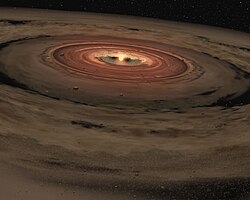astro.wikisort.org - Star
OTS 44 is a free-floating planetary-mass object or brown dwarf located at 550 light-years (170 pc) in the constellation Chamaeleon near the reflection nebula IC 2631. It is among the lowest-mass free-floating substellar objects, with approximately 11.5 times the mass of Jupiter, or approximately 1.1% that of the Sun.[2][4] Its radius is not very well known and is estimated to be 23–57% that of the Sun.[1][3]
| Observation data Epoch J2000.0 Equinox J2000.0 | |
|---|---|
| Constellation | Chamaeleon |
| Right ascension | 11h 10m 11.5s |
| Declination | −76° 32′ 13″ |
| Characteristics | |
| Spectral type | M9.5[1] |
| Astrometry | |
| Distance | 554 ly (170 pc) |
| Details | |
| Mass | 0.011[2] M☉ |
| Radius | 0.23[1]–0.57[3] R☉ |
| Luminosity | 0.0013[1]–0.0024[3] L☉ |
| Temperature | 1,700[2][3]–2,300[1] K |
| Database references | |
| SIMBAD | data |
OTS 44 was discovered in 1998 by Oasa, Tamura, and Sugitani as a member of the star-forming region Chamaeleon I.[5][6] Based upon infrared observations with the Spitzer Space Telescope and the Herschel Space Observatory, OTS 44 emits an excess of infrared radiation for an object of its type, suggesting it has a circumstellar disk of dust and particles of rock and ice.[1][3][7] This disk has a mass of at least 10 Earth masses.[3][contradictory] Observations with the SINFONI spectrograph at the Very Large Telescope show that the disk is accreting matter at the rate of approximately 10−11 of the mass of the Sun per year.[3] It could eventually develop into a planetary system. Observations with ALMA detected the disk in millimeter wavelengths. The observations constrained the dust mass of the disk between 0.07 and 0.63 MEarth, but these mass estimates are limited by assumptions on poorly constrained parameters.[8]
See also
- SCR 1845-6357, a binary system comprising a red dwarf and a brown dwarf
- Cha 110913-773444, an astronomical object that may be a free-floating planet surrounded by what appears to be a protoplanetary disk
References
- Luhman, K. L.; et al. (February 2005), "Spitzer Identification of the Least Massive Known Brown Dwarf with a Circumstellar Disk", The Astrophysical Journal, 620 (1): L51–L54, arXiv:astro-ph/0502100, Bibcode:2005ApJ...620L..51L, doi:10.1086/428613
- Bonnefoy, M.; Chauvin, G.; Lagrange, A.-M.; Rojo, P.; Allard, F.; Pinte, C.; Dumas, C.; Homeier, D. (2014). "A library of near-infrared integral field spectra of young M-L dwarfs". Astronomy & Astrophysics. 562 (127): A127. arXiv:1306.3709. Bibcode:2014A&A...562A.127B. doi:10.1051/0004-6361/201118270.
- Joergens, V.; Bonnefoy, M.; Liu, Y.; Bayo, A.; Wolf, S.; Chauvin, G.; Rojo, P. (2013). "OTS 44: Disk and accretion at the planetary border". Astronomy & Astrophysics. 558 (7): L7. arXiv:1310.1936. Bibcode:2013A&A...558L...7J. doi:10.1051/0004-6361/201322432.
- Luhmann, K. L.; Peterson, D. E.; Megeath, S. T. (2004). "Spectroscopic Confirmation of the Least Massive Known Brown Dwarf in Chamaeleon". The Astrophysical Journal. 617 (1): 565–568. arXiv:astro-ph/0411445. Bibcode:2004ApJ...617..565L. doi:10.1086/425228.
- Tamura, M.; Itoh, Y.; Oasa, Y.; Nakajima, T. (1998). "Isolated and Companion Young Brown Dwarfs in the Taurus and Chamaeleon Molecular Clouds". Science. 282 (5391): 1095–7. Bibcode:1998Sci...282.1095T. doi:10.1126/science.282.5391.1095. PMID 9804541.
- Oasa, Y.; Tamura, M.; Sugitani, K. (1999). "A Deep Near-Infrared Survey of the Chamaeleon I Dark Cloud Core". The Astrophysical Journal. 526 (1): 336–343. Bibcode:1999ApJ...526..336O. doi:10.1086/307964.
- "Blurring the lines between stars and planets: Lonely planets offer clues to star formation". MPIA Science Release 2013-09. Retrieved 1 September 2014.
- Bayo, Amelia; Joergens, Viki; Liu, Yao; Brauer, Robert; Olofsson, Johan; Arancibia, Javier; Pinilla, Paola; Wolf, Sebastian; Ruge, Jan Philipp; Henning, Thomas; Natta, Antonella (May 2017). "First Millimeter Detection of the Disk around a Young, Isolated, Planetary-mass Object". Astrophysical Journal Letters. 841 (1): L11. Bibcode:2017ApJ...841L..11B. doi:10.3847/2041-8213/aa7046. hdl:10150/624481. ISSN 0004-637X.
External links
- Astronomers Discover Beginnings of 'Mini' Solar System (Spitzer Space Telescope)
- MPIA Science Release 2013-09 - Blurring the lines between stars and planets: Lonely planets offer clues to star formation
На других языках
[de] OTS 44
OTS 44 ist ein Objekt planetarer Masse oder Brauner Zwerg im Sternbild Chamäleon in einer Entfernung von etwa 550 Lichtjahren (170 pc). Es hat eine Masse zwischen 5 und 17 Jupitermassen, mit dem wahrscheinlichsten Wert bei etwa 11,5 Jupitermassen oder 1,1 % der Sonnenmasse.[4] Es ist damit einer der masseärmsten nicht gravitativ an einen größeren Körper gebundenen substellaren Objekte, die wir kennen (Stand November 2014), und höchstwahrscheinlich ein Objekt planetarer Masse; seine Masse liegt jedoch nicht sicher unter der unteren Grenzmasse für Braune Zwerge (13 Jupitermassen). 2004 wurde es mit einer Masse von 15 Jupitermassen als kleinster seinerzeit bekannter Brauner Zwerg beschrieben, der von einer protoplanetaren Scheibe umgeben ist.[5]- [en] OTS 44
[es] OTS 44
OTS 44 (2MASS J11100934-7632178)[1] es una enana marrón a unos 554 años luz de distancia del sistema solar en la constelación de Chamaeleon. Fue descubierta en 2005 por un equipo dirigido por Kevin Luhman utilizando el Observatorio Gemini en Chile. Hasta el descubrimiento de Cha 110913-773444 —que no se sabe si es un planeta con lunas o una enana marrón con planetas— era la enana marrón conocida más pequeña.[ru] OTS 44
OTS 44 — одиночный коричневый карлик в южном околополюсном созвездии Хамелеона. Находится на расстоянии 550 световых лет от Земли. Он был наименьшим известным коричневым карликом, пока в том же созвездии не открыли объект Cha 110913-773444 (который относится к субкоричневым карликам, но сформировался из центра газопылевого облака, а не из его остатков, в отличие от планет типа Юпитера).Другой контент может иметь иную лицензию. Перед использованием материалов сайта WikiSort.org внимательно изучите правила лицензирования конкретных элементов наполнения сайта.
WikiSort.org - проект по пересортировке и дополнению контента Википедии
